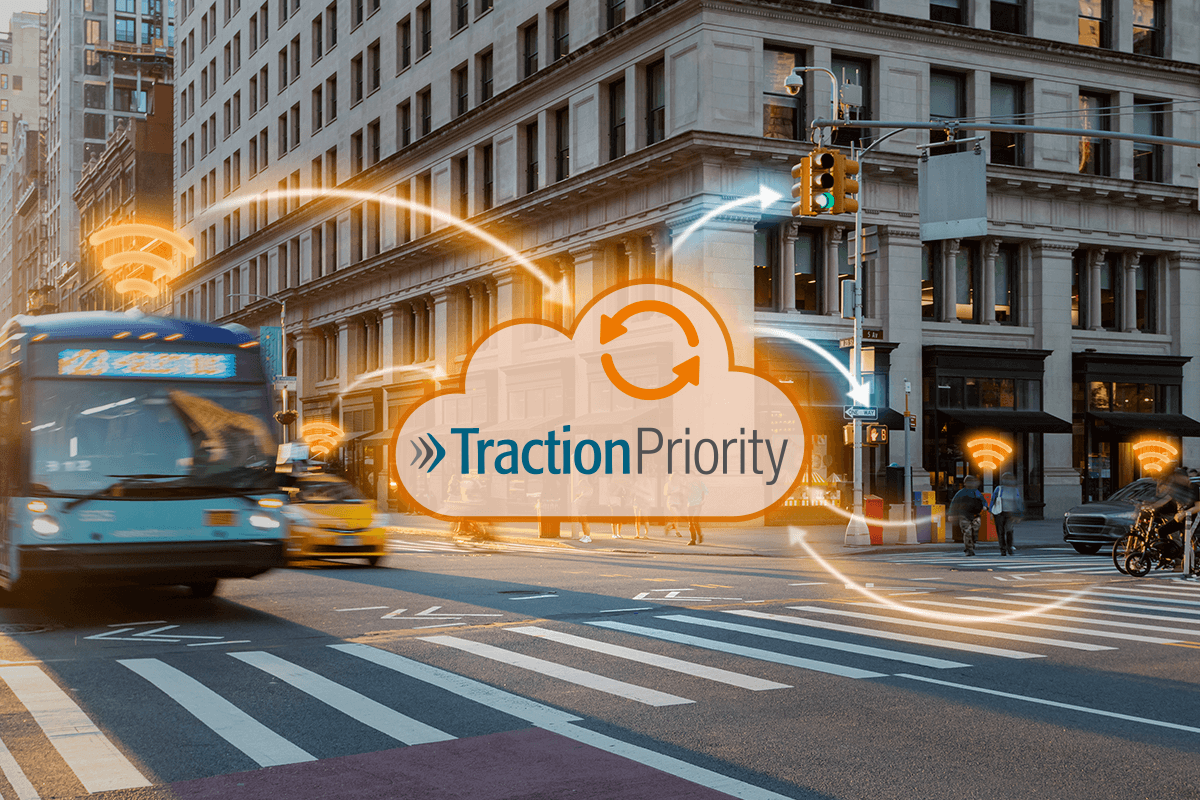- December 15, 2023
- Perspectives
Top 5 Vehicles Benefitting from Traffic Signal Priority and Emergency Vehicle Preemption


Jason Castillo
Software Project Manager

Seth Searle
Software Project Manager
The first electric traffic signal appeared in the US in 1914, revolutionizing transportation and improving safety and efficiency. By the 1960s, computers communicated with signals and allowed traffic planners to view their status remotely.
Two decades later, engineers began designing and building centralized traffic control software systems across entire cities. Today, advanced algorithms help improve traffic flow in real-time, and the latest software includes all forms of traffic signal priority.
Traffic Efficiency Through Integration
Beyond supporting efficient traffic flow and safety, traffic signals have evolved to mitigate negative environmental impacts, and even help save lives by changing their operations for high-priority vehicles. Two types of technology automatically modify signal timings: traffic signal priority (TSP) and emergency vehicle preemption (EVP).
Historically, these were two separate hardware-based solutions. EVP would change abruptly for approaching emergency vehicles, and TSP would have a more gradual adjustment for approaching vehicles such as public buses.
Now, integrated AI-powered solutions such as Kimley-Horn’s centralized priority software, Traction Priority ™ can manage both in a single offering. The process is simple: when a vehicle enters a virtual detection zone, the centralized priority software issues a command to the signal controller based on the vehicle type. The signal controller then initiates the priority action, such as keeping the traffic light green or starting the green early. This helps the vehicle pass through the intersection more safely while cross traffic waits longer behind red lights and pedestrians receive a longer “Don’t Walk” signal. The command ends once the vehicle exits the zone, and the traffic signal reverts to its previous settings.
1. Emergency Vehicles
Ensuring that police vehicles, ambulances, and fire trucks get to a scene quickly and safely can be the difference between life and death. Unfortunately, emergency vehicles travel with a speed and urgency that carries an inherent risk of crashes with commuters.
In 2021, 198 people died in the US due to crashes with emergency vehicles—many of whom occupied non-emergency vehicles. The National Highway Traffic Safety Administration reports approximately 6,500 accidents involving ambulances each year, and in 2020 there were an estimated 15,675 fire truck collisions.
EVP has the potential to decrease these numbers by increasing intersection safety for commuters, emergency responders, and pedestrians. A centralized software approach to EVP lowers maintenance and deployment costs, making EVP more affordable in medium and large cities.
2. Public Transit
A study conducted by the Census Bureau in 2019 found that about A study in 2019 found that about 5% of US workers rely on public transit to get to their jobs, and it takes them an average of 46.6 minutes to reach their desired locations each day (compared with 28 minutes on average for those who drive to work). In some large cities with effective transit systems, commuting ridership can exceed 50%. Optimizing traffic signals for public transit helps trains, trams, and buses adhere to their schedules and reduce their overall travel times.
Public transportation also produces lower greenhouse gas emissions per passenger mile than private vehicles. More reliable and efficient schedules and less idling time can increase people’s willingness to use public transportation, thereby lowering their carbon footprints.
3. School Buses
Giving school buses priority improves student safety, fuel consumption, and travel time. A 2023 study showed that 92% of school officials reported a shortage in bus drivers—an increase from 88% in 2022. The lack of drivers means many operators drive the same bus for both an early route and a late route, causing thousands of students to be late for school. For example, in North Carolina, the Wake County Public School System risks more than 2,000 students arriving late every day due to its bus driver shortage.
A TSP solution can move school buses through their routes more quickly. This allows school transportation planners to add more stops to bus routes across the country without changing the runtime, and it helps students get to school faster.
4. Freight Trucks
Nearly every consumer good can be traced back to freight vehicles. The Federal Highway Administration found that if trucks stopped delivering, assembly lines would also stop within 12 hours. Within one day, hospitals would begin to run out of essential supplies. Within two days, gas stations would begin to run out of fuel. And within three days, grocery stores would begin to run out of perishables.
Based off this information, getting freight to their location in a timely manner is imperative to keep daily life running. According to the North Central Texas Council of Governments, every 5,000 freight stops eliminated at traffic lights can save fleets:
- 3,800 minutes of travel
- $1,500 in fuel and operational costs
- Four miles per gallon in fuel efficiency
- 1,300 kilograms of emissions
These widespread benefits are a win for companies, truckers, commuters, and the planet.
5. Snowplows
More than 70% of roads in the US are in snowy areas, and almost 70% of the US population lives in these areas. Every year, approximately 900 people are killed and 76,000 are injured in car crashes during snowfall.
State and local governments may operate snowplows, and many locations contract snowplow services to private companies. Centralized TSP software cost-effectively improves road safety for all vehicles by moving snowplows through more green lights so they can clear roads faster, reducing the risk of collisions at slick intersections.
More than 50% of fatal or injury-related crashes across the US happen at or near intersections. Intelligent signal management reduces the likelihood of vehicles running red lights and colliding with other vehicles or road users. This is especially true for high-priority vehicles. By granting preemption and priority status, the traffic system proactively manages drivers, rather than drivers reacting to large and urgent vehicles. This gives planners the flexibility to manage traffic for both maximum efficiency and safety.
Submit the form below to learn more about Traction Priority.
About the Authors

Jason Castillo
Jason has more than 30 years of combined project management and ITS software development experience. His project experience includes system design, software development, ITS operations, and integration services at more than 15 unique arterial and freeway systems across the US and Canada. Jason also has extensive traffic signal system and data analysis experience and has served as project manager for numerous signal system deployment projects, including for the City of Austin, City of San Antonio, City of Tallahassee, Los Angeles County, Maricopa County, Virginia Department of Transportation, and City of Glendale.

Seth Searle
Seth has 15 years of experience with software development, software verification and validation, integration and testing, and project management. His background includes designing and developing Kimley-Horn Smart City Solutions, conducting manual and automated software test procedures, creating software installation packages, documenting help files, and generating and exercising acceptance test procedures. He works closely with end users to configure and optimize their Kimley-Horn software installations and serves as the development lead for many key software features. Seth also takes a lead role providing comprehensive software training to end users and working with agencies to fine-tune and optimize their Kadence adaptive traffic control system deployments.
